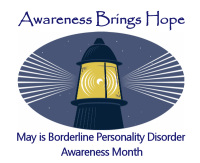 Whether you have been diagnosed with Borderline Personality Disorder (BPD) or know someone who has the psychiatric disorder, a diagnosis of BPD can be overwhelming and confusing.
Whether you have been diagnosed with Borderline Personality Disorder (BPD) or know someone who has the psychiatric disorder, a diagnosis of BPD can be overwhelming and confusing.
This month, designated as Borderline Personality Disorder Awareness Month, is a good time to do some more research on BPD and BPD treatment so that you become more familiar with the challenges you are facing.
BPD Statistics
The National Education Alliance for Borderline Personality Disorder (NEA for BPD) has released the following statistics on BPD during Borderline Personality Disorder Awareness Month:
- About 18 million Americans will develop Borderline Personality Disorder in their lifetimes
- 10 percent of people who present for outpatient treatment have BPD
- 10 percent of adults with BPD commit suicide, and 33 percent of youth who commit suicide have features of BPD
- 38 percent of adults with BPD are prescribed three or more medications, but no U.S. Food and Drug Administration (FDA)-approved medication exists for BPD
- 60 percent of people with BPD also have major depression
- 50 percent of people with Borderline Personality Disorder are severely impaired in employment
Report to Congress on BPD
In an attempt to help people better understand Borderline Personality Disorder, the House Committee on Appropriations requested that the Substance Abuse and Mental Health Services Administration (SAMHSA) prepare a report with recommendations on expanding early detection, evidence-based treatment, and family education.
SAMHSA’s Report to Congress on Borderline Personality Disorder presents research and key findings on those topics. Here are some of the report’s findings:
- Although BPD does have a surprisingly good prognosis in the long term, such symptoms as self-injury and suicidality are extremely dangerous — individuals diagnosed with BPD have a suicide rate approximately 50 times that of the general population
- The self-harmful behaviors that are often present in people with BPD can emerge as young as ages 10-12 years
- Individual and group psychotherapy, skills training, family psychoeducation, pharmacotherapy, and peer support are among the empirically based interventions for BPD
- In the last two decades, there has been an increase in the number of relevant evidence-based practices, but there is still a need for additional research to support best practices in the field
- Family members of individuals with a diagnosis of BPD report very high levels of depression, grief, isolation, and hopelessness associated with their loved one’s illness and may be at risk for developing their own psychiatric problems
- Family psychoeducation to increase family members’ understanding of BPD not only helps them develop appropriate ways to deal with stress and maintain bonds with their loved ones, it also correlates strongly with improved outcomes for the individual with a diagnosis of BPD
There are endless resources out there when it comes to finding out about Borderline Personality Disorder. Make sure you take the time to do the research that will answer your questions about BPD and help you or a loved one get the BPD treatment needed for a long-term recovery.




2 Comments
Pingback: Where to Find True Stories of People with Borderline Personality Disorder | Borderline Personality Treatment
Pingback: BPD Awareness Month: Facts about Borderline Personality Disorder